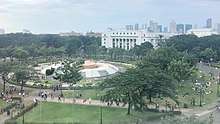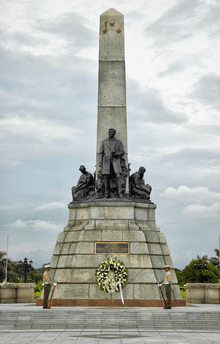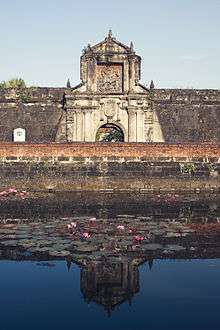Statue of the Sentinel of Freedom
The Statue of the Sentinel of Freedom or the Lapu Lapu Monument is a monument to Lapu-Lapu located at Rizal Park specifically at the center of the Agrifina Circle.[1]
| Coordinates | 14.584248°N 120.9814171°E |
|---|---|
| Location | Rizal Park, Manila |
| Designer | Erick James Francisco |
| Material | Bronze |
| Height | 12.19 metres (40.0 ft) (including 3.05 metres (10.0 ft) pedestal) |
| Opening date | February 5, 2004 |
| Dedicated to | Lapu-Lapu |
Design and symbolism

A brainchild of former Tourism Secretary Richard Gordon, the project is known as "The Statue of the Sentinel of Freedom". It is a gift of the Korea Freedom League to the Filipino people. The monument was conceptualized to give recognition to the first Asian who fought against foreign invasion.
According to the former tourism chief, the location of the statue of Lapu-Lapu is highly significant. From the shores of Laguna de Bai following the pathway to Luneta, one will find the monument of Lapu-lapu some distance behind the monument of Dr. Jose Rizal, the national hero of the Philippines.
Gordon said "Lapu-Lapu was the first Asian to lead a successful uprising against foreign invasion, while Rizal was the first Asian to spur the idea of anti-colonialism."
"Having the statues of Rizal and Lapu-Lapu at the old Bagumbayan (now Rizal Park or Luneta) is highly historical. It is our way of giving recognition to two great men in Philippine history. 'Bagumbayan' is the new country which Rizal dreamed of, but never saw ... a country free from oppression and colonial bondage," Gordon added.
The 30-foot "Statue of the Sentinel of Freedom" monument stands on a 10-foot pedestal and depicts Lapu-Lapu not in battle. Instead, the hero is shown standing guard, holding his kampilan, which is concealed in its scabbard and firmly planted on the ground. Gordon observes that the hero's face conveys strength and determination but with such great kindness and a stance that exudes power and vigilance.
"This monument would like to impart the message that the Filipino is a 'man of peace' yet is ready to protect his territory and people if threatened," Gordon added.
Juan Sajid Imao, the statue's sculptor and a 2001 TOYM awardee for the arts, further noted, "The statue shows Lapu-Lapu as strong and peace loving but at the same time ready to defend himself against those who trample on his cherished freedom."
Tourism Undersecretary Oscar Palabyab further noted that Lapu-Lapu was chosen for the project not so much for his victory over Magellan but because of what he stands for in history.
Lapu-Lapu is known in world history as the leader of a native tribe in Central Philippines who defeated in 1521 the Portuguese conquistador Ferdinand Magellan. Magellan, who was under the service of the king of Spain, is the first man to circumnavigate the world. After the historic battle, the Spanish empire took 35 years before they would set foot again on what is now the Philippines.
The Korean Freedom League headed by Chairman Kwon Jung-dal will present the monument to the Filipino people as a gesture of their friendship and appreciation for the sacrifices of Filipinos and Koreans in defense of freedom and democracy.
History
In 2004, House of Representatives members Raul del Mar and Nerissa Corazon Soon-Ruiz initiated the installation of a statue of Lapu-Lapu in Rizal Park as a move to honor Lapu-Lapu as a hero of not only Cebu but the whole Philippines.[2] They urged the Office of the President to an accept their proposal.[3]
The statue was unveiled on February 5, 2004. The Korean Freedom League led by Chairman Kwon Jung-dal[1] donated ₱15 million for the casting of the statue.[4]
In 2014, Lapu-Lapu City Mayor Paz Radaza requested the transfer of the statue to Punta Engaño of her city where she plans to put it in an island to be made at the tip of the locality. This proposal came up after Radaza talked to Tourism Secretary Ramon Jimenez, Jr. where the National Historical Institute’s (NHI) opinion that the statue could "desecrate" Rizal Park was brought up.[2] The moved was opposed by Raul del Mar who said that the move would be detrimental and will cause a “loss of honor and recognition” to the province and Cebu and Lapu-Lapu.[3]
See also
References
- "DOT unveils Lapu-Lapu monument at Luneta". Lakbay Pilipinas Online. 5 February 2004. Retrieved 2 June 2016.
- Mendoza, Norman (3 July 2014). "Radaza insists on taking Lapu-Lapu statue from Luneta". Cebu Daily News. Retrieved 2 June 2016.
- "Don't move Lapu-Lapu statue to Cebu yet, says congressman". Cebu Daily News. 29 June 2014. Retrieved 2 June 2016.
- Mendez, Christina (17 January 2006). "Lapu-Lapu: Symbol of Pinoy pride". The Philippine Star. Retrieved 2 June 2016.

